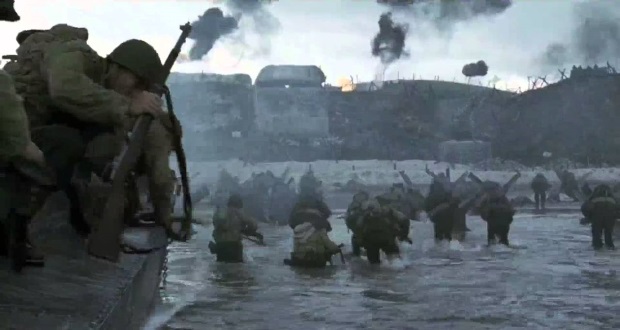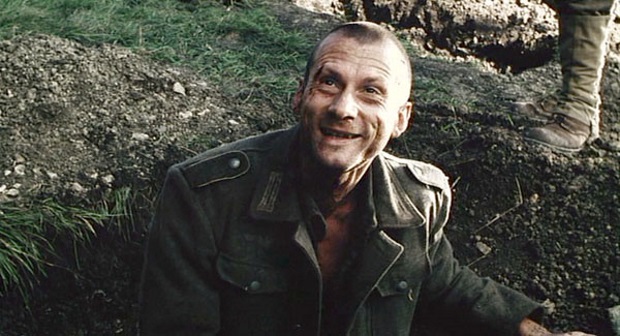How the Secret of Saving Private Ryan’s Power Lies in its Portrayal of the Enemy
20 years on, Steven Spielberg's Saving Private Ryan is very one-sided, and just as horrifying.
This article comes from Den of Geek UK.
When Saving Private Ryan first shell-shocked cinema-goers some 20 years ago, the modern war movie was born. Steven Spielberg had brought audiences closer to the carnage and bloodshed of the Second World War than they had ever been before, pioneering a frighteningly realistic style which has since set the benchmark for the genre. As a result, much has been written about the film’s innovative use of prosthetic gore, thundering sound effects, and shaky, desaturated cinematography, all of which help to capture the sights, sounds, and sensations of combat with sometimes sickening verisimilitude.
However, communicating the physical experience of war is only part of the films power; more crucial is how Spielberg helps us to understand its corrosive effect on the human soul. Fundamental to this mission is the film’s detached treatment of the German enemy. As their humanity is stripped away with alarming ease, we begin to realize how ordinary soldiers can justify and rationalise the barbarity of war.
Throughout the film, Spielberg strives to place his audience into the boots of an American GI during the 1944 Battle for Normandy, resulting in a fiercely one-sided perspective on the conflict. This sympathetic focus on the film’s American heroes is contrasted violently, and necessarily, with a distant and inhumane portrayal of the German Wehrmacht who oppose them. So forcefully are the audience made to empathize with the Americans and despise the Germans that we almost become complicit in the cruelty of the film’s violence. Similarly, the moral complexities and quandaries which arise for the protagonists are made more powerful by placing the viewer so firmly into their mindset, removing our usual sense of separation and impartiality.

From the earliest moments of the film, as American troops storm the blood-soaked sands of Omaha Beach, Spielberg fixes the German defenders at a clear distance. They are little more than silhouettes, crouched behind snarling machine guns or scuttling between imposing fortifications. Meanwhile, our helplessly exposed protagonists are slaughtered by this almost invisible and apparently invulnerable enemy. The cries of wounded and dying Americans are lingered upon as German bullets and shells eviscerate them, their terror and frustration palpable. The perpetrators of this violence, the German soldiers perched atop the French coast, quickly become obscure objects of hatred and bloodlust.
When the tables are eventually turned and these Germans become victim to American firepower, their suffering receives no such sympathy. They remain little more than faceless cannon fodder to be riddled with bullets and destroyed without remorse. Their deaths are not a tragic loss, but a satisfying moment of retribution, as the Americans expunge their pent-up rage from the morning’s battle.
The callousness with which violence is dealt upon the Germans is a core feature of the film and its commentary on the inhumanity of combat. One of war’s most horrifying consequences is the visceral hatred and inhumanity it breeds between total strangers, and Saving Private Ryan communicates this sensation in its dehumanization of the enemy. Indeed, conveying this to a modern audience often comes at the cost of historical accuracy. When German soldiers are glimpsed up-close, they all appear to sport anachronistically close-cropped hairstyles, more reminiscent of modern-day Neo-Nazi skinheads than authentic 1940s styles. In such a way, the audience’s existing prejudices and preconceptions about the Nazi war machine are indulged and encouraged by the film, fermenting the same blind hatred and fear experienced by the GIs on the beach.

This singular and fiercely subjective approach used by Saving Private Ryan represented a departure from classics of the war genre, which would often endeavour to tell both sides of the story. A quintessential example is Daryl F. Zanuck’s 1962 epic, The Longest Day. Like Saving Private Ryan, it depicted the Normandy Landings of 6th June 1944, but rather than focusing on a small squad of US soldiers, Zanuck gave a sweeping overview of the entire battle – including lengthy sequences from a German perspective. A similar approach was adopted for many other war films of the era, including The Battle Of The Bulge (1965), The Bridge At Remagen (1969), Battle Of Britain (1969), Tora! Tora! Tora! (1970), and A Bridge Too Far (1977). These films were not about individual characters, but events, of which all sides had to be taken in account to produce a coherent picture.
Saving Private Ryan, however, makes no such attempt at objectivity, with occasionally shocking results. When a bunker full of German defenders is set ablaze by a flamethrower and an American onlooker cries “don’t shoot, let ‘em burn” as a swarm of writhing bodies emerge from the flames, the audience shares in the dreadful catharsis of watching the Germans suffer. Likewise, when surrendering Germans are cut down remorselessly by vengeful GIs, their brutality is understandable, even reasonable.
The one-sided empathy that develops over the course of the film plays a particularly crucial role in a later sequence, when Tom Hanks’ Captain Miller and his squad capture a German soldier who may have been responsible for the death of their friend. As the Americans debate what to do with their helpless captive – to take revenge and execute him, or have mercy and let him go – their dilemma becomes the audience’s own. So forcefully have we been made to identify with the American soldiers and share in their pain that it becomes impossible to remain an objective bystander.

It is debatable whether such an intentionally biased portrayal of the Second World War is a wholly positive influence. Its value for historians is almost nil, and watching the film you would be forgiven for believing than the United States invaded France and defeated Nazi Germany without assistance. The only reference to any of America’s allies in the war, let alone their enemies, is when a US paratrooper offers a brief and stinging criticism of the “overrated” British General Bernard Montgomery. This is just one reason why Saving Private Ryan has been accused of promoting conservative ideas around patriotism and American exceptionalism, despite its technical innovation. This argument is certainly supported by the image of a fluttering American flag which awkwardly bookends the film.
However, it is not Spielberg’s intention to argue that all Americans are naturally heroes, and all Germans naturally evil, but to demonstrate how easily war may rob ordinary people of their compassion for their fellow man. As Captain Miller says himself, “I just know that every man I kill the farther away from home I feel.” To despise and wish death upon another person is not an enviable quality, but a sickening necessity in the conduct of war. Spielberg does not pass judgement on these ugliest of human impulses, but simply strives to understand them.
To attack the film for its lack of scope or historical authenticity is, to a certain extent, to miss the point. For any film fan who wishes to understand the minutiae of the Normandy Landings from every possible perspective, The Longest Day remains an excellent starting point. Saving Private Ryan makes no claim to be a historical record of the Second World War, or even of D-Day, but it does attempt to explore the minds of the men who fought it for an audience who, mercifully, have never faced such horrors.
